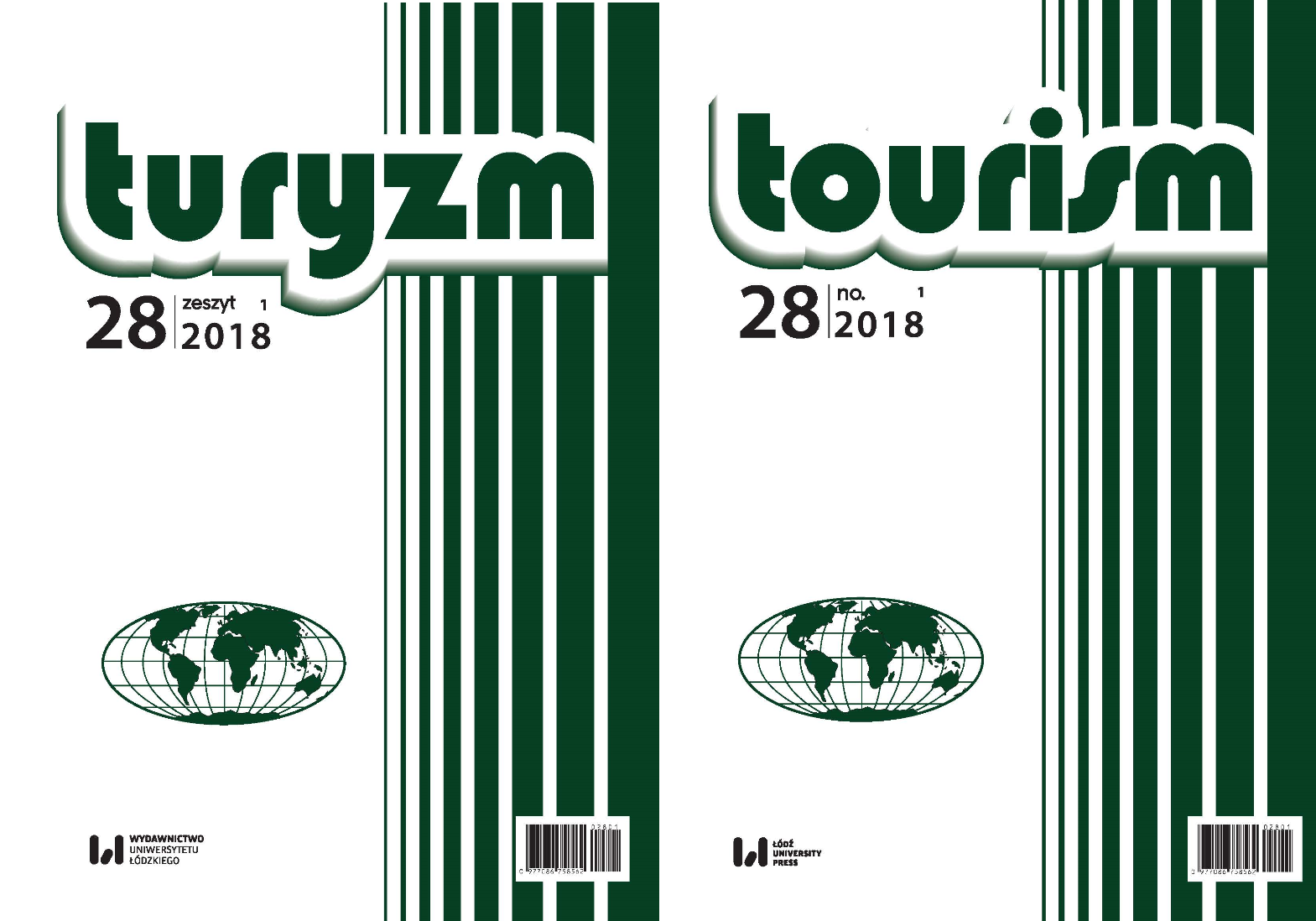The attractiveness of selected Central European countries for winter sports and mountain hiking
DOI:
https://doi.org/10.18778/0867-5856.28.1.12Keywords:
tourist attractiveness, winter sports, mountain hiking, Central EuropeAbstract
Hiking, downhill skiing and snowboarding are among the most popular forms of active tourism in mountainous areas. Their popularity and their mass scale do not only result from the presence of the appropriate landscape, but also from its appropriate development. The objective of the article is to attempt to assess the attractiveness of selected Central European countries in terms of winter sports and mountain hiking, to consider the opinions of students who live in Visegrad Group countries, as well as to evaluate the barriers to development of their competitive offers. According to respondents, the most attractive countries for winter sports are Austria and Slovakia, and the least attractive are Hungary, Romania and Lithuania. In turn, according to the students, the best conditions for mountain hiking are in Slovakia, Austria, the Czech Republic and Poland. In addition, respondents from particular countries assessed domestic offers highly.
Downloads
References
ANDREJUK A., 1998, Turystyka aktywna, rekreacyjna i specjalistyczna, Kengraf, Warszawa.
Google Scholar
DUDEK D., 2006, Pojęcie rekreacji w polskiej tradycji terminologicznej, Folia Touristica, 17, pp. 27-50.
Google Scholar
FALK M., 2010, A dynamic panel data analysis of snow depth and winter tourism, Tourism Management, 31, 6, pp. 912-924.
Google Scholar
FIDELUS J., 2016, Slope transformations within tourist foot-paths in the northern and southern parts of the Western Tatra Mountains (Poland, Slovakia), Zeitschrift für Geomorphologie, 60 (3), pp. 139-162.
Google Scholar
FIDELUS-ORZECHOWSKA J., GORCZYCA E., KRZEMIEŃ K., 2017, Geomorfologiczne skutki gospodarki turystycznej w Tatrach, Wyd. IGiGP UJ, Kraków.
Google Scholar
FLAGESTAD A., HOPE C. A., 2001, Strategic success in winter sports destinations: a sustainable value creation perspective, Tourism Management, 22 (5), pp. 445-461.
Google Scholar
GENELETTI D., DAWA D., 2009, Environmental impact assessment of mountain tourism in developing regions: A study in Ladakh, Indian Himalaya, Environmental Impact Assessment Review, 29 (4), pp. 229-242.
Google Scholar
HAVRLANT J., 2011, Kierunki i bariery modernizacji ośrodków sportów zimowych w czeskim regionie turystycznym ‘Beskidy’, Prace Geograficzne, 125, pp. 77-93.
Google Scholar
HERBIN J., 1995, Mass tourism and problems of tourism planning in French mountains, [in:] G.J. Alshworth, A.G. Dietvorst (eds.), Tourism and spatial transformations, CABI, Wallingford.
Google Scholar
HOLDEN A., 2000, Winter tourism and the environment in conflict: the case study of Cairngorm, Scotland, International Journal of Tourism Research, 2, 4, pp. 247-260.
Google Scholar
HUDSON S., 2000, Snow business. A study of the international ski industry, Cassell, London.
Google Scholar
HUDSON S., HUDSON L., 2015, Winter sport tourism, Goodfellow Publishers, Oxford.
Google Scholar
KIEŁBASIEWICZ-DROZDOWSKA I., 2001, Zarys rozwoju refleksji teoretycznej nad problematyką rekreacji, [in:] I. Kiełbasiewicz-Drozdowska, W. Siwiński (eds.), Teoria i metodyka rekreacji, AWF, Poznań, pp. 9-25.
Google Scholar
KRZESIWO K., 2007, Turystyka narciarska w Beskidzie Śląskim – stan obecny i problemy rozwoju, [in:] W. Kurek, R. Faracik (eds.), Studia nad turystyką. Prace geograficzne i regionalne. Geograficzne, społeczne i ekonomiczne aspekty turystyki, Instytut Geografii i Gospodarki Przestrzennej, Uniwersytet Jagielloński, Kraków, pp. 85-97.
Google Scholar
KRZESIWO K., 2014, Rozwój i funkcjonowanie stacji narciarskich w polskich Karpatach, Instytut Geografii i Gospodarki Przestrzennej, Uniwersytet Jagielloński, Kraków.
Google Scholar
KUREK W., 2004, Turystyka na obszarach górskich Europy, Instytut Geografii i Gospodarki Przestrzennej, Uniwersytet Jagielloński, Kraków.
Google Scholar
LINDBERG K., ANDERSSON T.D., DELLAERT B.G.C., 2001, Tourism development: Assessing social gains and losses, Annals of Tourism Research, 28, 4, pp. 1010-1030.
Google Scholar
LUBOWIECKI-VIKUK A.P., PASZYŃSKA-JĘDRYCKA M., 2010, Współczesne tendencje w rozwoju form rekreacyjnych i turystycznych, AWF, Poznań.
Google Scholar
MADZIKOVÁ A., KLAMÁR R., ROSIČ M., KAŇUK J., 2011, Główne kierunki i problemy rozwoju turystyki narciarskiej w Republice Słowackiej, Prace Geograficzne, 125, pp. 111-128.
Google Scholar
MIKA M., 2009, Ski tourism in the Polish Carpathians – present state and issues of development, Folia Geographica. Acta Facultatis Studiorum Humanitatis et Naturae Universitatis Presoviensis, 14, pp. 198-208.
Google Scholar
MIKA M., KRZESIWO K., KRZESIWO P., 2007, Współczesne problemy rozwoju ośrodków narciarskich w Polsce – przykład Szczyrku, Prace Geograficzne, 117, pp. 63-77.
Google Scholar
PILAWSKI A., 2002, Skrajne formy aktywności fizycznej, [in:] I. Jędrzejczyk (ed.), Rozwój funkcji turystycznej i rekreacyjnej polskich obszarów górskich, Akademia Wychowania Fizycznego w Katowicach, Katowice, pp. 88-93.
Google Scholar
RUT J., 2002, Turystyka aktywna w Euroregionie Karpackim. Monografia turystyczna, Wyd. Uniwersytetu Rzeszowskiego, Rzeszów.
Google Scholar
SZCZECHOWICZ B., 2006, Funkcjonowanie schronisk turystycznych jako przedsięwzięć komercyjnych, [in:] A. Rapacz (ed.), Gospodarka turystyczna w regionie. Przedsiębiorstwo, samorząd, współpraca, Wyd. Akademii Ekonomicznej we Wrocławiu, Jelenia Góra, pp. 134-142.
Google Scholar
SZCZECHOWICZ B., 2014, Poziom i zróżnicowanie cen usług noclegowych oferowanych przez schroniska górskie na terenie Karpat Polskich, Słowackich i Czeskich, [in:] J. Kantyka (ed.), Wellness jako forma kultury fizycznej i turystyki – aspekty zdrowotne i ekonomiczne, Wyd. Akademii Wychowania Fizycznego w Katowicach, Katowice, pp. 126-148.
Google Scholar
TSUYUZAKI S., 2002, Vegetation development patterns on ski slopes in lowland Hokkaido, northern Japan, Biological Conservation, 108, 2, pp. 239-246.
Google Scholar
TÖGLHOFER CH., 2011, From climate variability to weather risk: The impact of snow conditions on tourism demand in Austrian ski areas, doctoral thesis, University of Graz, Graz.
Google Scholar
TUPPEN J., 2002, Recent developments in alpine tourism: A life cycle approach, Turyzm, 12, 2, pp. 79-93.
Google Scholar
WARSZYŃSKA J., 1995, Geografia turystyczna świata, 1, PWN, Warszawa.
Google Scholar
WOLAŃSKA T., 1997, Leksykon – sport dla wszystkich, rekreacja ruchowa, AWF, Warszawa.
Google Scholar
ZARZYCKI P., STOSIK A., GROBELNY J., 2006, Specyfika funkcjonowania schronisk górskich w świetle zmian otoczenia gospodarczego i dynamiki rozwoju sektora turystyki w Polsce, Prace Naukowe Akademii Ekonomicznej we Wrocławiu, 1141, pp. 303-309.
Google Scholar
ŻEMŁA M., 2000, Turystyka kwalifikowana w okresie transformacji w Polsce, [in:] L. Żabiński (ed.), Uwarunkowania środowiskowe strategii marketingowych w wybranych sektorach gospodarki, Wyd. Akademii Ekonomicznej w Katowicach, Katowice, pp. 199-234.
Google Scholar
ŻEMŁA M., 2014, Foreign tourists on hiking trials in Polish mountains, Geomatics Landmanagement and Landscape, 1, pp. 95-106.
Google Scholar
ŻEMŁA M., 2015, Reakcje gestorów schronisk na rezerwacje mailowe w różnych językach. Porównanie obiektów w Polsce, Czechach i Słowacji, Folia Turistica, 36, pp. 125-142.
Google Scholar
Downloads
Published
How to Cite
Issue
Section
License

This work is licensed under a Creative Commons Attribution-NonCommercial-NoDerivatives 4.0 International License.










